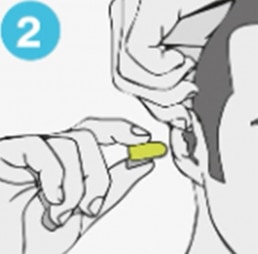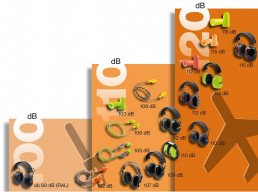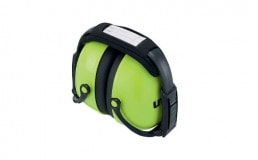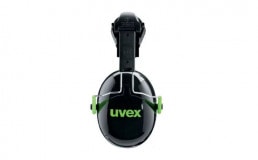Whether working with machines on a daily basis or simply attending a brief visit to the production hall, as soon as employees are exposed to noise at work, they must be protected against hearing damage by means of the correct personal protective equipment (PPE). The two most reliable forms of hearing protection are earmuffs and earplugs. But how do you know which of the two is the right hearing protection for the situation at hand and what are the differences between them? In this blog article, we explain to you everything you need to know.
Why is hearing protection so important?
Hearing constitutes one of our five senses. Although our ears are designed for hearing, over time, noise can become irritating and cause permanent hearing damage. In the worst cases, this can even lead to complete hearing loss. According to a study carried out by the Robert Koch Institute (RKI), five percent of all respondents suffered from minor hearing difficulties. Meanwhile, six percent of people over the age of 65 were affected by major hearing difficulties. Generally, there is a distinction between noise that can generate risks if a person is continuously exposed to it and noise that is so loud that hearing damage can be caused when a person is exposed to it just once.
Everyday noise exposure – in decibels (dB):
- 55 dB: Noise at this level makes it difficult to work on tasks that require a high and consistent level of concentration.
- 60 dB: Noise at this level is equivalent to the sound level of a standard conversation or standard office noise.
- 85 dB: The sound produced by devices such as vacuum cleaners and hand drills is around 85 dB. Being exposed to sound this loud for 40 hours per week over a long period of time will lead to hearing damage. This is why occupational health and safety prescribes mandatory hearing protection starting from 85 dB.
- 120 dB: Noise levels of 120 dB and over are above the ear’s pain threshold. This level of noise is immediately uncomfortable for people and can damage hearing even upon a single exposure. Noise caused by industrial and building machinery such as hammer drills, pneumatic drills and chain saws can reach this critical level.
This is why hearing protection at the workplace is laid down by law. Important regulatory points of reference include the German Occupational Safety and Health Act, the German Noise and Vibrations Occupational Safety and Health Ordinance and the German PPE Usage Regulation. When it comes to everyday work environments, both earplugs and earmuffs can be used to protect hearing.
Hearing protection earplugs – small and practical
Earplugs are a reliable aid for protecting your ears from loud noise both in leisure and professional environments. Hearing protection earplugs are made of flexible materials such as foam or silicone. When used at work, they are often connected with a cord to make sure they don’t get lost. Earplugs are placed in the ear canal to prevent the penetration of sound waves. There are two different types of earplugs: disposable earplugs (also known as single-use earplugs) and reusable earplugs.
Disposable earplugs
As the name suggests, single-use earplugs should be thrown away after they have been used once. Generally, this type of hearing protection is made from soft, open-pored foam on which dirt and ear discharge can stick. If these earplugs are used more than once, these bacteria or viruses can get into the ear canal causing inflammation or similar issues. This is why you must take note of hygiene instructions when using hearing protection earplugs.
If you are using single-use earplugs, it’s important to insert them correctly:

Roll the earplug so it can be easily inserted into your ear canal. When doing this, make sure you have clean hands.

Stretch your other arm over your head and pull your ear slightly upwards. This straightens and widens your ear canal.

Insert the hearing protection earplug into your ear canal and hold it firmly in place for a moment. This prevents the hearing protection earplug from falling out when unfolding. If the earplug is not protruding from the ear and is not visible from the front, then it is in the perfect position. Use a mirror to help you make sure you have positioned the earplug correctly. If the earplug does not fit properly, try a different size.
Reusable earplugs
The alternative to single-use earplugs are reusable earplugs. These can be worn more than once over a longer period of time. However, if you opt for these earplugs, you must make sure to clean them regularly. For this, use specialised cleaning wipes or mild soap and water. Dry the hearing protection carefully and put it away in its specific storage box until you need to use it again. A further advantage of reusable earplugs is the supporting clip which means you do not need to touch the part of the earplug that is in direct contact with the ear with your hands. This allows the hearing protection to be inserted even with dirty hands.
Earmuffs – reliable noise protection
In addition to conventional earplugs, earmuffs can also be used to protect your hearing. These consist of two earpieces connected by a headband. The earpieces encase the outer ear, whilst the cushions ensure the ears are well sealed. This prevents harmful sound waves from penetrating and protects the wearer’s hearing.
With several different solutions for combining helmets with earmuffs, wearing a safety helmet at work doesn’t mean you can’t wear earmuffs too. For those wanting to connect their hearing protection to their helmets permanently, the uvex K10H, K20H and K30H helmet earmuffs are the perfect solution. For those wanting a little more flexibility, our uvex pheos K2P hearing protection is a great choice as its magnetic connection allows the earmuffs to be adapted to individuals and the specificities of their work. When no longer needed, the hearing protection earmuffs can easily be removed with a simple click, reducing the weight for the wearer and relieving the muscles in the neck. It goes without saying that the entire helmet and hearing protection system can also be combined with a uvex pheos visor.
Earplugs or earmuffs – which is the right type of hearing protection for me?
Both earplugs and earmuffs effectively protect your ears from noise-related damage. Which of the two will work best for you depends on several different factors. These include what insulation level you require, what preferences you have and what type of environment you work in.
#1: Comparing hearing protection – insulation levels
The most important thing about hearing protection is that people actually wear it. At the same time, the hearing protection you use must have the right insulation level to protect your hearing from sounds that are too loud. There are many different versions of earplugs and earmuffs available, all offering different insulation levels. However, it’s not the case that earmuffs consistently provide better insulation levels than earplugs or vice versa. This is why it’s always important to take careful note of the attenuation values provided by the manufacturer. This said, for best hearing protection, a combination of earmuffs and earplugs is recommended. The level of sound insulation necessary for different workplaces is determined on a case-by-case basis within the framework of a risk assessment.

#2: Personal preferences
Whether you opt for hearing protection earplugs or earmuffs when working also depends on your own personal preferences. Some people find wearing earplugs uncomfortable as they can cause a feeling of pressure. Earmuffs are very easy to use and, generally, very comfortable. However, the combination of earmuffs with some glasses models can lead to a reduction in the insulation levels provided. This is why uvex offers you a wide range of safety spectacles, enabling a variety of different combinations.
#3: Hearing protection and hygiene
A key factor when choosing the right hearing protection for you is your working environment. Generally speaking, earplugs are almost always a suitable choice for protecting your hearing from damage caused by noise exposure. However, when using hearing protection earplugs, please always take note of the applicable hygiene guidelines. If you work in a dirty environment or if your hands are susceptible to getting dirty at work, it’s essential that when inserting disposable earplugs into your ear canal, you do so prior to starting work and with clean hands. This is because the dirt from your hands or workplace can stick to the plugs. If you then insert the dirty plugs into your ear canal, the impurities can get inside your ear and may cause inflammation and other issues. Therefore, earmuffs tend to be the best and safest form of hearing protection when it comes to accommodating the specific requirements of these types of working environments. If you do use hearing protection earmuffs, uvex offers hygiene kits for changing the sealing cushions when needed.
Which form of hearing protection is best for hunting and shooting?
Whether you hunt for leisure, hunt professionally, work as a police officer or are part of a shooting sports club, handling rifles and pistols generates a lot of noise – between 120 and 160 dB. This is why it’s extremely important to make sure you use the right hearing protection when shooting. The peak noise level that you will be exposed to plays a decisive role, making it essential to ensure the insulation level of your chosen hearing protection is sufficient. You can choose to use either earplugs or earmuffs. Some forms of protection even combine earplugs with earmuffs to keep the sound as far away from your ear as possible.
Hearing protection which enables situational awareness of ambient noise is something that is also frequently required. This is known as active hearing protection. For this, the uvex aXess one is the ideal solution. With its RAL (Real Active Listening) function, this hearing protection allows you to perceive ambient noise even whilst wearing hearing protection. An electronic sound level limiter prevents noises that are too loud from damaging your ears and the individual five-level volume setting can even help enhance hearing.
Otoplastics for individually adapted hearing protection
If you have difficulties finding hearing protection that fits properly or if you wear hearing protection on a daily basis, there is – in addition to earmuffs and earplugs – another option. This alternative consists of hearing protection otoplastics which are individually adapted to the wearer’s ear, offering unparalleled comfort and secure fit. uvex has a range of different otoplastics made from a variety of materials available for you to choose from. Find out more today.
Optimum hearing protection from the uvex range
Whether you’re looking for earmuffs, hearing protection earplugs or otoplastics, at uvex, you’ll find the perfect model that fulfils all relevant PPE requirements applicable to you and your work. Benefit from our many years of experience and equip yourself and your employees with high-quality personal protective equipment that offers the ideal fit.





